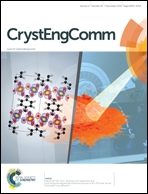Temperature and electric field induced phase transition in [110]C-oriented 0.63Pb(Mg1/3Nb2/3)O3–0.37PbTiO3 single crystals
Abstract
Temperature-dependent domain configurations were studied for both unpoled and poled [110]C-oriented 0.63Pb(Mg1/3Nb2/3)O3–0.37PbTiO3 (PMN–0.37PT) single crystals by polarized light microscopy (PLM). Combining the dielectric properties and the domain configurations upon heating, it was found that the temperature-induced phase transition in the unpoled [110]C-oriented PMN–0.37PT single crystal followed the tetragonal (T) → cubic (C) sequence. However, under an electric (E) field of 10 kV cm−1 along the [110]C direction, a single domain orthorhombic (O) phase was induced. The E field-dependent domain structures were observed in situ under PLM, which verified that the T phase turned to O phase when an E field of 10 kV cm−1 was applied along the [110]C direction. Upon subsequent heating, the phase transition followed the O → T → C sequence. The O–T discontinuous phase transition led to a remarkable change in the dielectric coefficient and strain with increasing temperature. The strain at 45 °C (0.148%) was 2.2 times larger than that at room temperature (0.068%), accompanied by a tremendous piezoelectric coefficient ( ~1645 pm V−1).
~1645 pm V−1).
![Graphical abstract: Temperature and electric field induced phase transition in [110]C-oriented 0.63Pb(Mg1/3Nb2/3)O3–0.37PbTiO3 single crystals](/en/Image/Get?imageInfo.ImageType=GA&imageInfo.ImageIdentifier.ManuscriptID=C5CE01738F&imageInfo.ImageIdentifier.Year=2015)

 Please wait while we load your content...
Please wait while we load your content...